Ecological Flow Assessment: Balancing Trout and Grayling Habitat Ecology and Hydroelectric Production
Abstract
1. Introduction
2. Study Area Status
2.1. The Hydrology
2.2. Fish Population Ecology
2.3. The Dynamo Hydropower Plant
3. Methodology
3.1. Hydraulic and Habitat Modelling
3.2. Ecohydrological and Economic Assessment
4. Results
4.1. WUA Curves
4.2. Ecohydrological and Economic Assessment
Flow Allocation for the Six Scenarios
5. Discussion
5.1. Habitat Ecology for Brown Trout and Grayling
5.2. Ecohydrological and Economic Analysis of the Dynamo Power Plant
6. Conclusions
Author Contributions
Funding
Institutional Review Board Statement
Informed Consent Statement
Data Availability Statement
Acknowledgments
Conflicts of Interest
Abbreviations
| FOEN | Federal Office of the ENvironment |
| HSI | Habitat Suitability Index |
| WUA | Weighted Usabel Area |
| IHA | Indicators of Hydrological Alteration |
| S1 | Sector S1 is situated downstream of the studied sector (see Figure 3). |
| S2 | Sector S2 is situated midstream of the studied sector (see Figure 3). |
| Mean flow of the flow duration curve at day 347. [m3/s] | |
| Current operating flow rate of the hydropower plant. [m3/s] | |
| Power output of the Dynamo hydropower plant. [J/s] | |
| Overall efficiency of the hydroelectric plant. [−] | |
| Density of water (considered constant). [kg/m3] | |
| Gravitational acceleration. [m/s2] | |
| Average net head of the Dynamo hydropower plant. [m] | |
| I | Upstream flow coming to the dam. [m3/s] |
| Upstream flow value at which competition between ecological and economic | |
| indices begins. [m3/s] | |
| Upstream flow value where competition between ecological and economic | |
| indices ends. [m3/s] | |
| Current ecosystem flows (river side). [m3/s] | |
| Minimum ecological flow (river side). [m3/s] | |
| Maximum operating flow (channel side). [m3/s] | |
| Minimum operating flow (channel side). [m3/s] | |
| Wetted area [m2] | |
| a | Adimensional parameter (Fermi function) affecting the shape of the curve. |
| b | Adimensional parameter (Fermi function) affecting the shape of the curve. |
| c | Adimensional parameter (Fermi function) fixing the curve arriving point at |
| . In this study, it is fixed at 1. | |
| i | Adimentional parameter (Fermi function), fraction of water left for the ecosystem |
| when (start of the competition between ecological and economic indices). | |
| j | Adimentional parameter (Fermi function), fraction of water left for the ecosystem |
| when (end of the competition between ecological and economic indices). | |
| Rate of non Attainment, part of the days for which the IHA deviate outside | |
| plus/minus one standard deviation, and the coefficient of variation. | |
| Coefficient of Variation, ratio between the standard deviation and the mean of the IHA. | |
| k | IHA indicator. |
| Root mean square distances between the simulated and natural . | |
| Root mean square distances between the simulated and natural . | |
| maximum number of consecutive days in which the river flow is below the critical | |
| WUA threshold for juvenile trouts. | |
| maximum number of consecutive days in which the river flow is below the critical | |
| WUA threshold for adult trouts. | |
| Eco | Dimensionless and synthetic ecohydrological indicator. |
| S | Non-proportional flow allocation scenario. |
| E | Hydroelectricity produced per year [GWh/year] |
| Current scenario using a fixed ecological flow method and an equipped | |
| flow of 2.55 m3/s. |
References
- Office Fédérale de L’énergie OFEN. Les Faits sur la Petite Hydraulique. OFEN. 2020. Available online: https://www.bfe.admin.ch/bfe/fr/home/versorgung/erneuerbare-energien/wasserkraft/kleinwasserkraft.exturl.html/aHR0cHM6Ly9wdWJkYi5iZmUuYWRtaW4uY2gvZnIvcHVibGljYX/Rpb24vZG93bmxvYWQvMTAzNTY=.html (accessed on 5 February 2024).
- Office Fédérale de L’énergie OFEN. Potentiel Hydroélectrique de la Suisse. OFEN. 2020. Available online: https://plattform-renaturierung.ch/wp-content/uploads/2019/09/Wasserkraftpotenzial_Schweiz_f.pdf (accessed on 5 February 2024).
- Di Giulio, M.; Angelone, S. Fiches sur l’aménagement et l’écologie des cours d’eau: Amélioration de la dynamique. OFEV. 2012. Available online: https://www.bafu.admin.ch/dam/bafu/fr/dokumente/wasser/uw-umwelt-wissen/merkblatt-sammlungwasserbauundoekologie.pdf.download.pdf/recueil_des_fichessurlamenagementetlecologiedescoursdeau.pdf (accessed on 10 December 2023).
- Lin, Q. Influence of Dams on River Ecosystem and Its Countermeasures. J. Water Resour. Prot. 2011, 2011, 3779. [Google Scholar] [CrossRef]
- Bammatter, L.; Baumgartner, M.; Greuter, L.; Haertel-Borer, S.; Huber, G.M.; Nitsche, M.; Thomas, G. Renaturation des eaux suisses: Plans d’assainissement des cantons dès 2015. OFEV. 2015. Available online: https://www.bafu.admin.ch/dam/bafu/fr/dokumente/wasser/fachinfo-daten/die_sanierungsplaenederkantoneab2015.pdf.download.pdf/plans_d_assainissementdescantonsdes2015.pdf (accessed on 2 April 2024).
- Estoppey, R.; Kiefer, B.; Greuter, L.; Kummer, M.; Lagger, S.; Aschwanden, H. Débit résiduel convenable, comment les déterminer? OFEV. 2000. Available online: https://www.bafu.admin.ch/dam/bafu/fr/dokumente/wasser/uv-umwelt-vollzug/angemessene_restwassermengenwiekoennensiebestimmtwerdenwegleitun.pdf.download.pdf/debits_residuelsconvenables-commentpeuvent-ilsetredeterminesinst.pdf (accessed on 15 December 2023).
- Pfammatter, R.; Wicki, N.S. Energieeinbussen aus Restwasser-Bestimmungen—Stand und Ausblick; Association Suisse pour l’Aménagement des Eaux: Zürich, Switzerland, 2018. [Google Scholar]
- Perona, P.; Dürrenmatt, D.J.; Tron, S.; Characklis, G.W. Obtaining natural-like flow releases in diverted river reaches from simple riparian benefit economic models. J. Environ. Manag. 2013, 118, 161–169. [Google Scholar] [CrossRef] [PubMed]
- Gorla, L.; Perona, P. On quantifying ecologically sustainable flow releases in a diverted river reach. J. Hydrol. 2013, 489, 98–107. [Google Scholar] [CrossRef]
- Razurel, P.; Gorla, L.; Tron, S.; Niayifar, A.; Crouzy, B.; Perona, P. Non-proportional Repartition Rules Optimize Environmental Flows and Energy Production. Water Resour. Manag. 2018, 30, 207–223. [Google Scholar] [CrossRef]
- Razurel, P.; Gorla, L.; Tron, S.; Niayifar, A.; Crouzy, B.; Perona, P. Improving the ecohydrological and economic efficiency of Small Hydropower Plants with water diversion. Adv. Water Resour. 2018, 113, 249–259. [Google Scholar] [CrossRef]
- Tschurr, F.; Mülchi, R.; Kotlarski, S.; Fischer, A.; Schlegel, T.; Duding, O.; Rajczak, J. Changements Climatiques Dans le Canton du Jura: Ce que l’on Sait et ce qui est Attendu Dans le Futur; NCCS National Center for Climate Services: Hague, The Netherlands, 2021. [Google Scholar]
- Hausmann, M. Petite Centrale hydroéLectrique de Courrendlin “Dynamo”, Analyse Sommaire; Internal report. Unpublished work; Office Fédérale de l’ENergie OFEN: Ittigen, Switzerland, 2012. [Google Scholar]
- Detert, M.; Weitbrecht, V. User Guide to Gravelometric Image Analysis by BASEGRAIN; Taylor and Francis Group: London, UK, 2013. [Google Scholar]
- Fehr, R. Einfache Bestimmung der Korngrössenverteilung von Geschiebematerial mit Hilfe der Linienzahlanalyse. Schweiz. Ing. Archit. 1987, 105, 1104–1109. [Google Scholar]
- Bovee, K.D. Development and Evaluation of Habitat Suitability Criteria for Use in the Instream Flow Incremental Methodology. In National Ecology Center, Division of Wildlife, Contaminant Research, Fish, and Wildlife Service; U.S. Department of the Interior: Washington, DC, USA, 1986. [Google Scholar]
- Plomb, J.; Zaugg, B. Rétablissement de la Migration du Poisson-Planification stratéGique; Federal Office for the Environment FOEN: Bern, Switzerland, 2021. [Google Scholar]
- Zaugg, B. Liste Rouge des Espèces Menacées en Suisse: Poisson et Cyclostomes; Federal Office for the Environment FOEN: Bern, Switzerland, 2022. [Google Scholar]
- Souchon, Y.; Trocherie, F.; Fragnoud, E.; Lacombe, C. Les modèles numériques des microhabitats des poissons: Application et nouveaux développements. Rev. Des Sci. L’Eau 1989, 2, 807–830. [Google Scholar]
- Mallet, J.P.; Lamouroux, N.; Sagnes, P.; Persat, H. Habitat preferences of European grayling in a medium size stream, the Ain river, France. JFB 2000, 2, 807–830. [Google Scholar] [CrossRef]
- Nestler, J.M.; Milhous, R.T.; Payne, T.R.; Smith, D.L. History and review of the habitat suitability criteria curve in applied aquatic ecology. River Res. Appl. 2019, 35, 1155–1180. [Google Scholar] [CrossRef]
- Richter, B.D.; Baumgartner, J.V.; Powell, J.; Braun, D.P. A Method for Assessing Hydrologic Alteration within Ecosystems. Conserv. Biol. 1996, 10, 11634174. [Google Scholar] [CrossRef]
- Bizzi, S.; Pianosi, F.; Soncini-Sessa, R. Valuing hydrological alteration in multi-objective water resources management. J. Hydrol. 2012, 472473, 277–286. [Google Scholar] [CrossRef]
- Capra, H.; Breil, P.; Souchon, Y. A New Tool to Interpret Magnitude and Duration of Fish Habitat Variations. Regul. Rivers Res. Manag. 1995, 10, 281–289. [Google Scholar] [CrossRef]
- Clasing, R.E.; Arumí, J.L.; Caamaño, D.; Alcayaga, H.; Medina, Y. Remote Sensing with UAVs for Modeling Floods: An Exploratory Approach Based on Three Chilean Rivers. Water 2023, 15, 1502. [Google Scholar] [CrossRef]
- Niayifar, A.; Oldroyd, H.; Lane, S.N.; Perona, P. Modeling Macroroughness Contribution to Fish Habitat Suitability Curves. Water Resour. Res. 2018, 54, 9306–9320. [Google Scholar] [CrossRef]
- Padoan, F.; Calvani, G.; De Cesare, G.; Brodersen, J.; Robinson, C.T.; Perona, P. Ecological and biogeomorphological modelling of brown trout (Salmo trutta L.). In River Research and Applications; Wiley Online Library: Hoboken, NJ, USA, 2024. [Google Scholar]
- Perona, P.; Niayifar, A.; Schwemmle, R.; Razurel, P.; Flury, R.; Winz, E.; Barry, D.A. Frontiers of (Pareto) Optimal and Sustainable Water Management for Hydropower and Ecology. Front. Environ. Sci. 2021, 9, 703433. [Google Scholar] [CrossRef]
- Office Fédéral de L’environnement OFEV. Rétablissement de la Migration du Poisson. OFEV. 2022. Available online: https://www.bafu.admin.ch/dam/bafu/fr/dokumente/wasser/uw-umwelt-wissen/wiederherstellung-fischwanderung.pdf.download.pdf/UW-2205-F_Fischwanderung.pdf (accessed on 21 March 2024).
- McKuin, B.; Zumkehr, A.; Ta, J.; Bales, R.; Viers, J.H.; Pathak, T. Energy and water co-benefits from covering canals with solar panels. Nat. Sustain. 2021, 4, 609–617. [Google Scholar] [CrossRef]
- Solar Thermal Shows Highest Energy Yield Per Square Metre. Available online: https://solarthermalworld.org/news/solar-thermal-shows-highest-energy-yield-square-metre/ (accessed on 30 August 2023).
- Bernhard, F.; Perona, P. Dynamical Behavior and Stability Analysis of Hydromechanical Gates. J. Irrig. Drain. Eng. 2017, 143, 04017039. [Google Scholar] [CrossRef]
- Martel, S.; Saharei, P.; De Cesare, G.; Perona, P. Dynamic environmental flows using hydrodynamic-based solutions for sustainable hydropower. In Role of Dams and Reservoirs in a Successful Energy Transition; CRC Press: Boca Raton, FL, USA, 2023. [Google Scholar]
- Niayifar, A. Dynamic water allocation policies improve the global efficiency of storage systems. Adv. in Water Resour. 2017, 104, 55–64. [Google Scholar] [CrossRef]
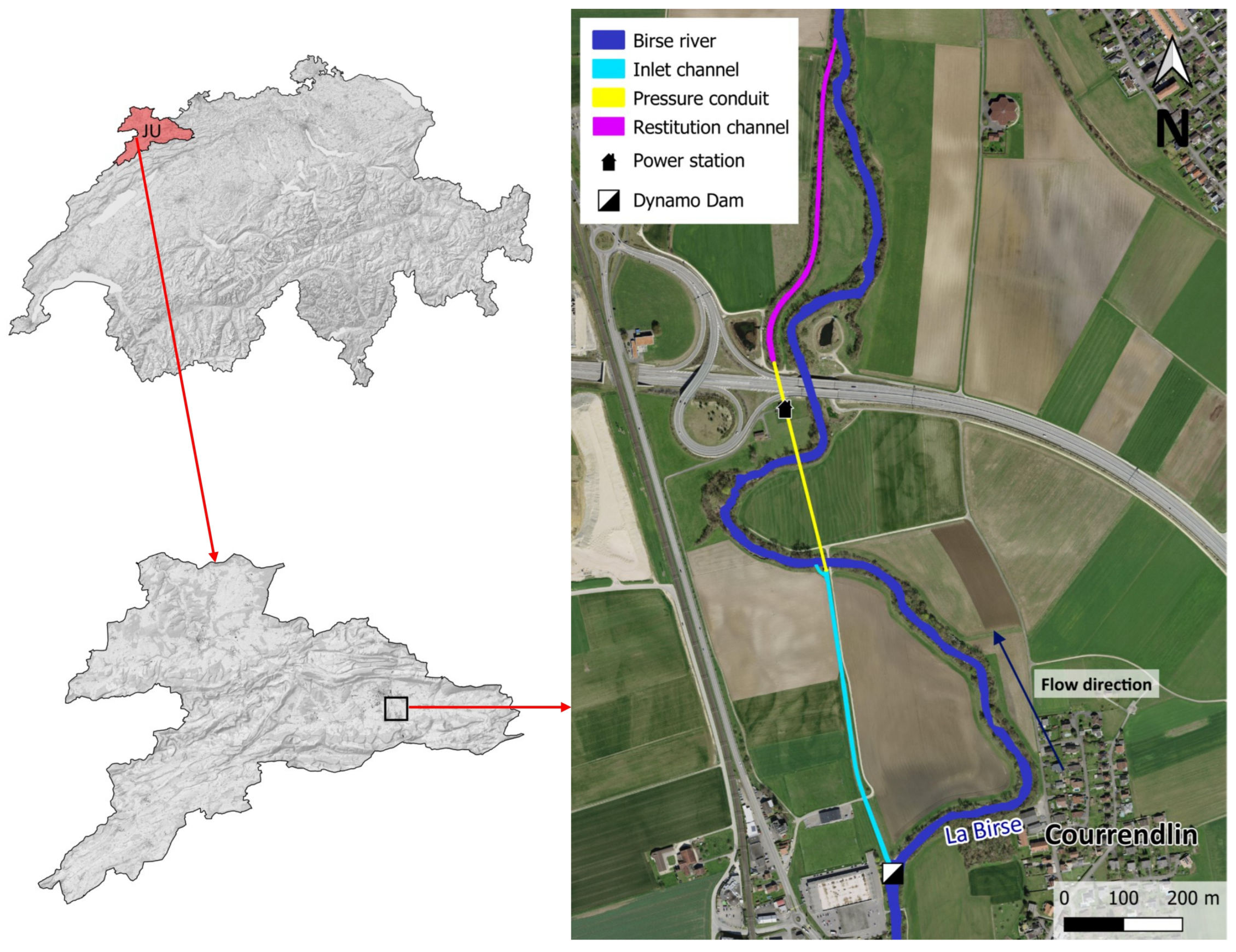
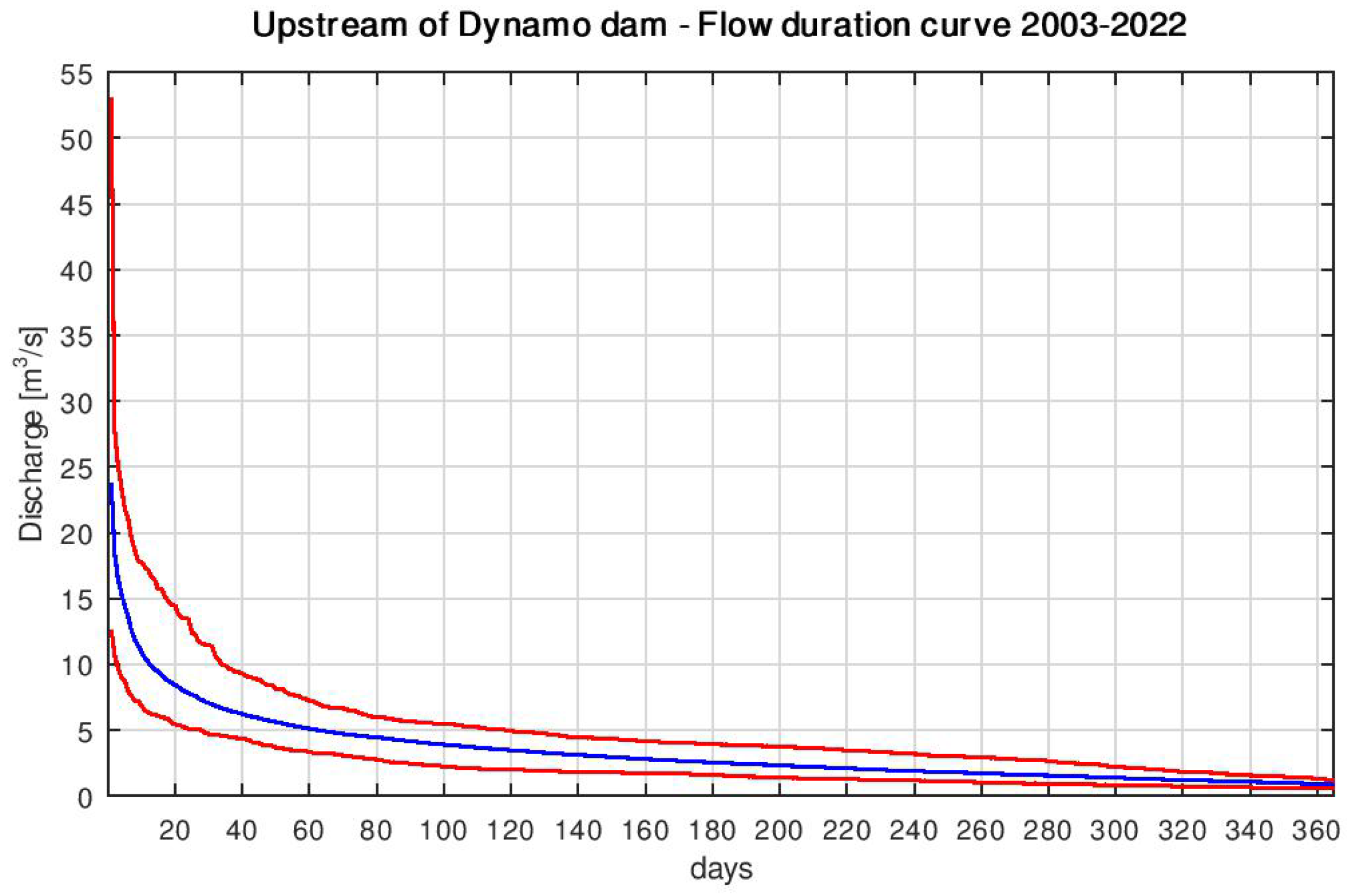
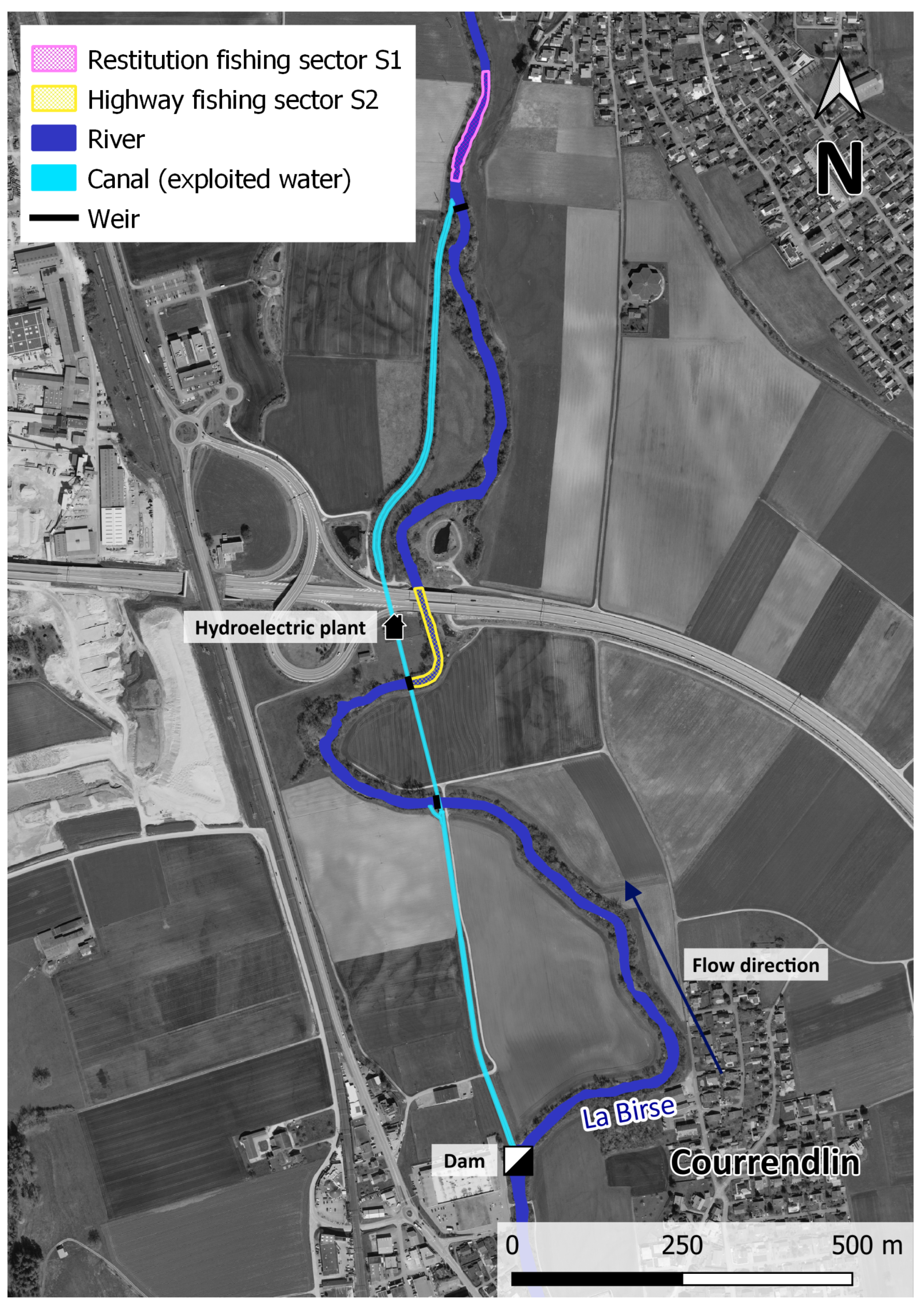

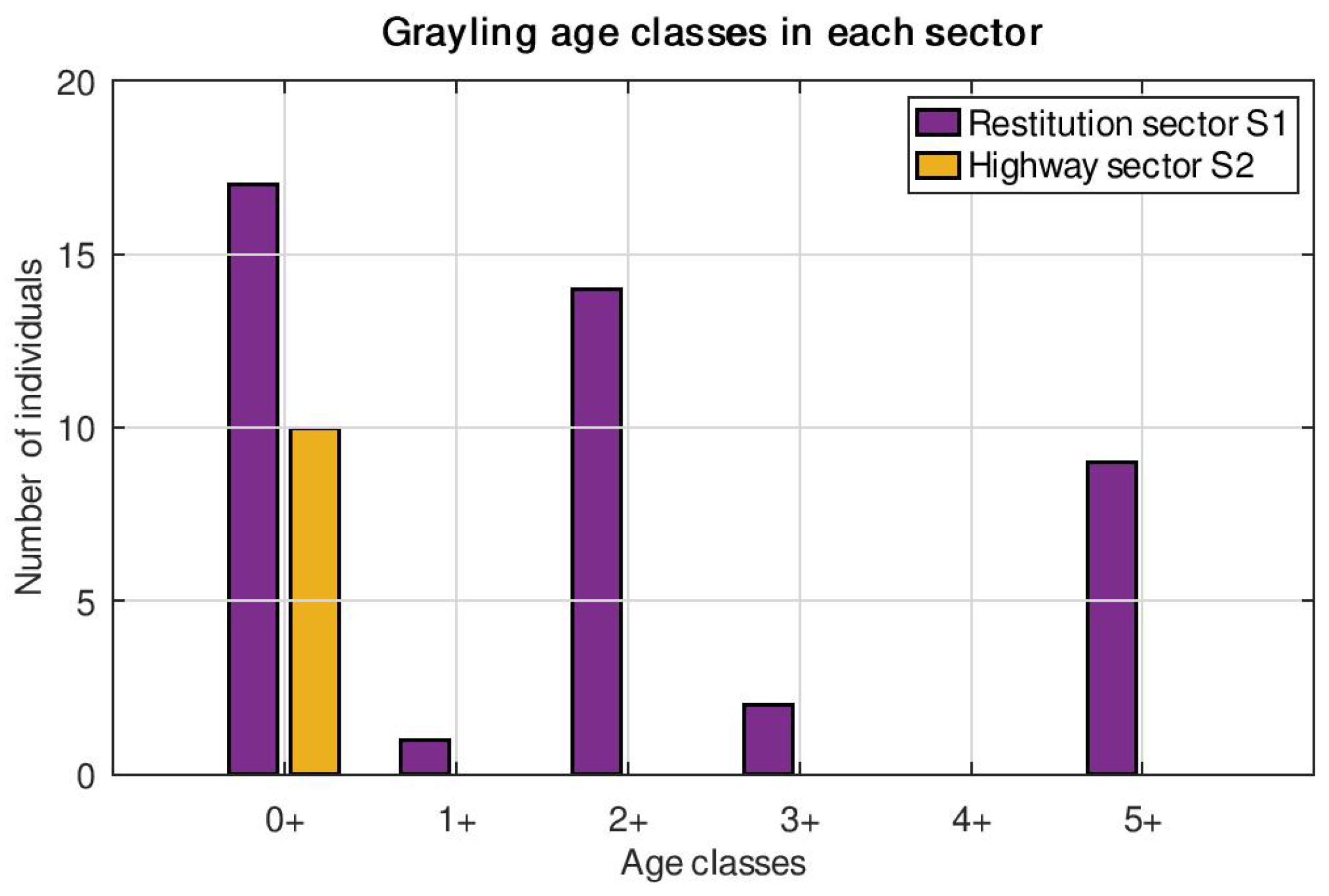
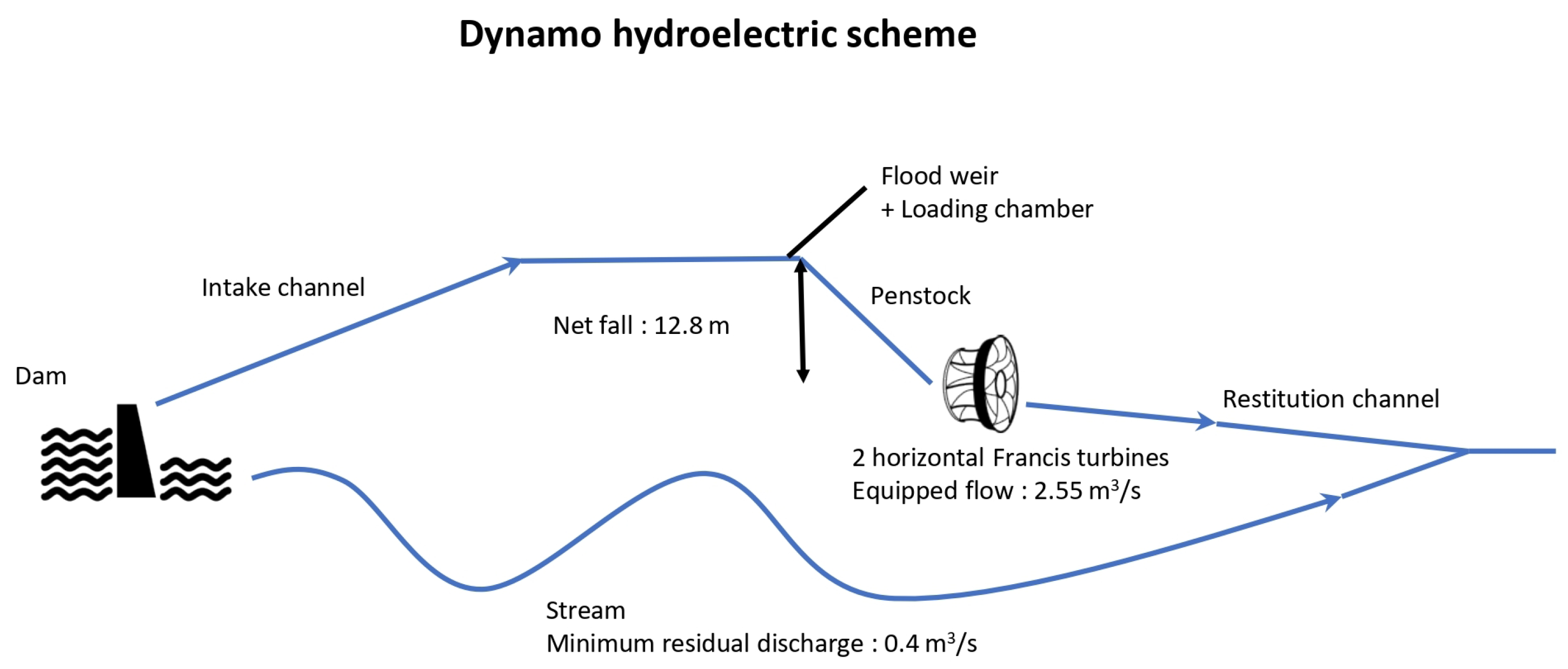
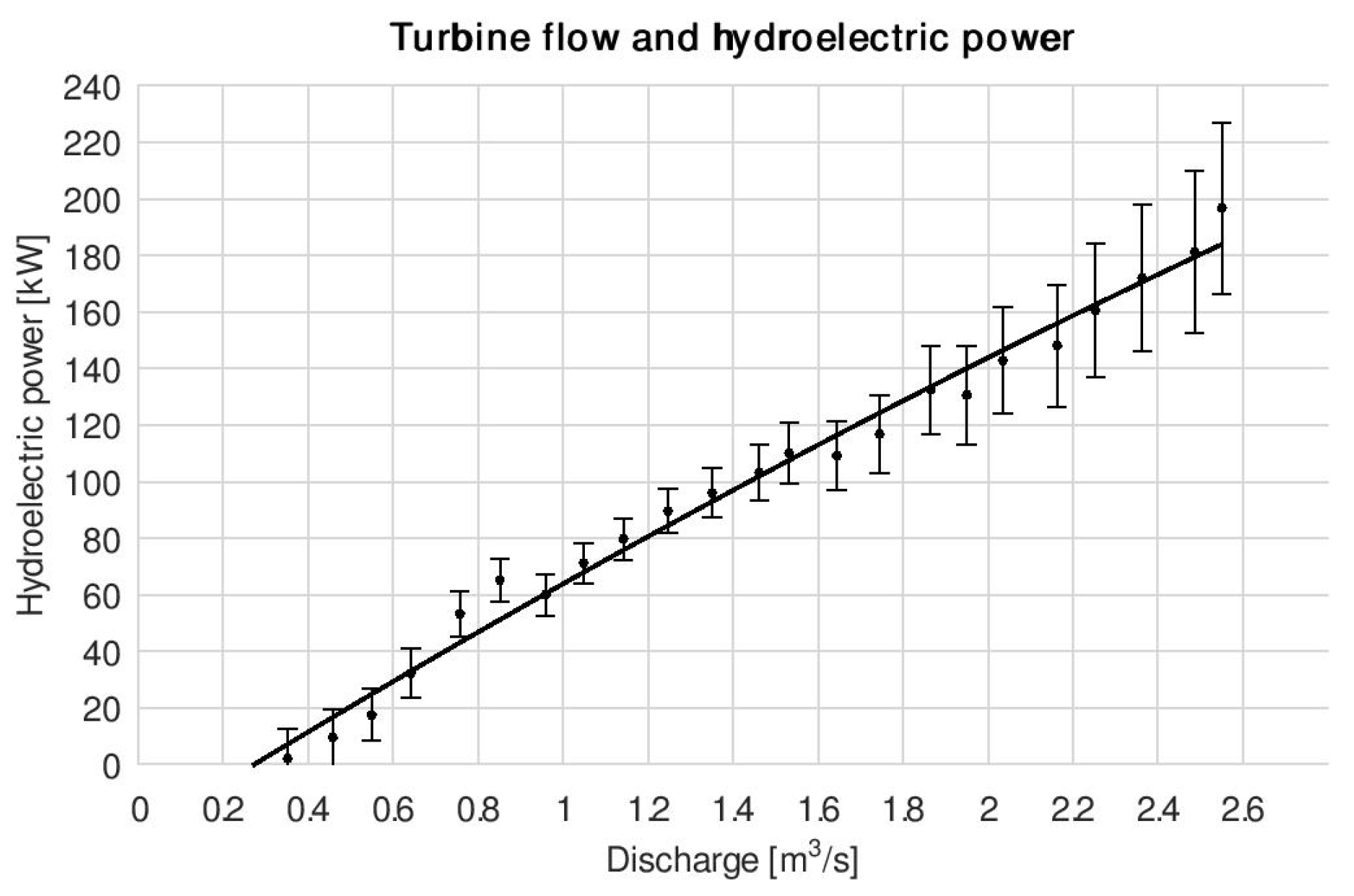
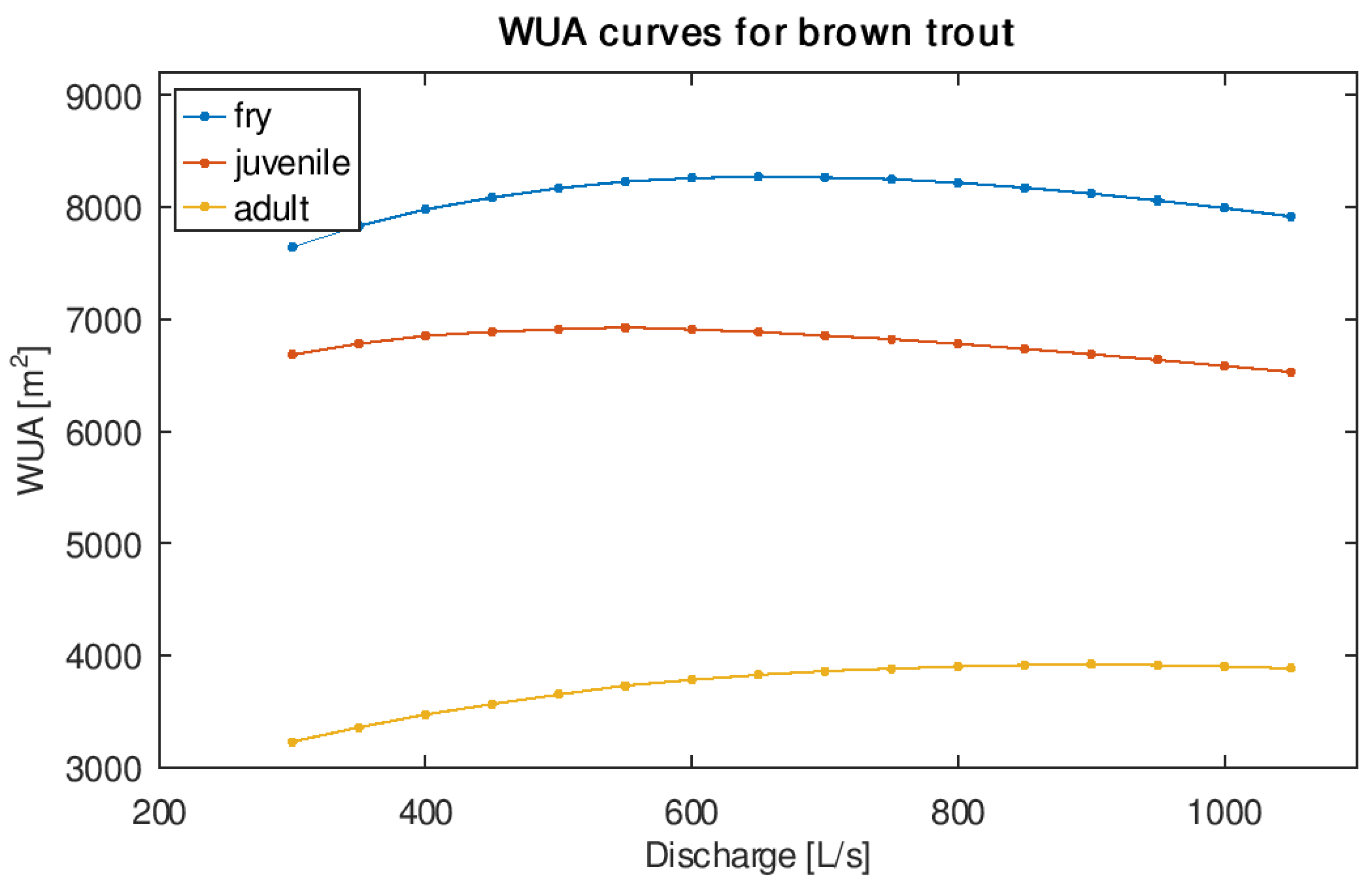


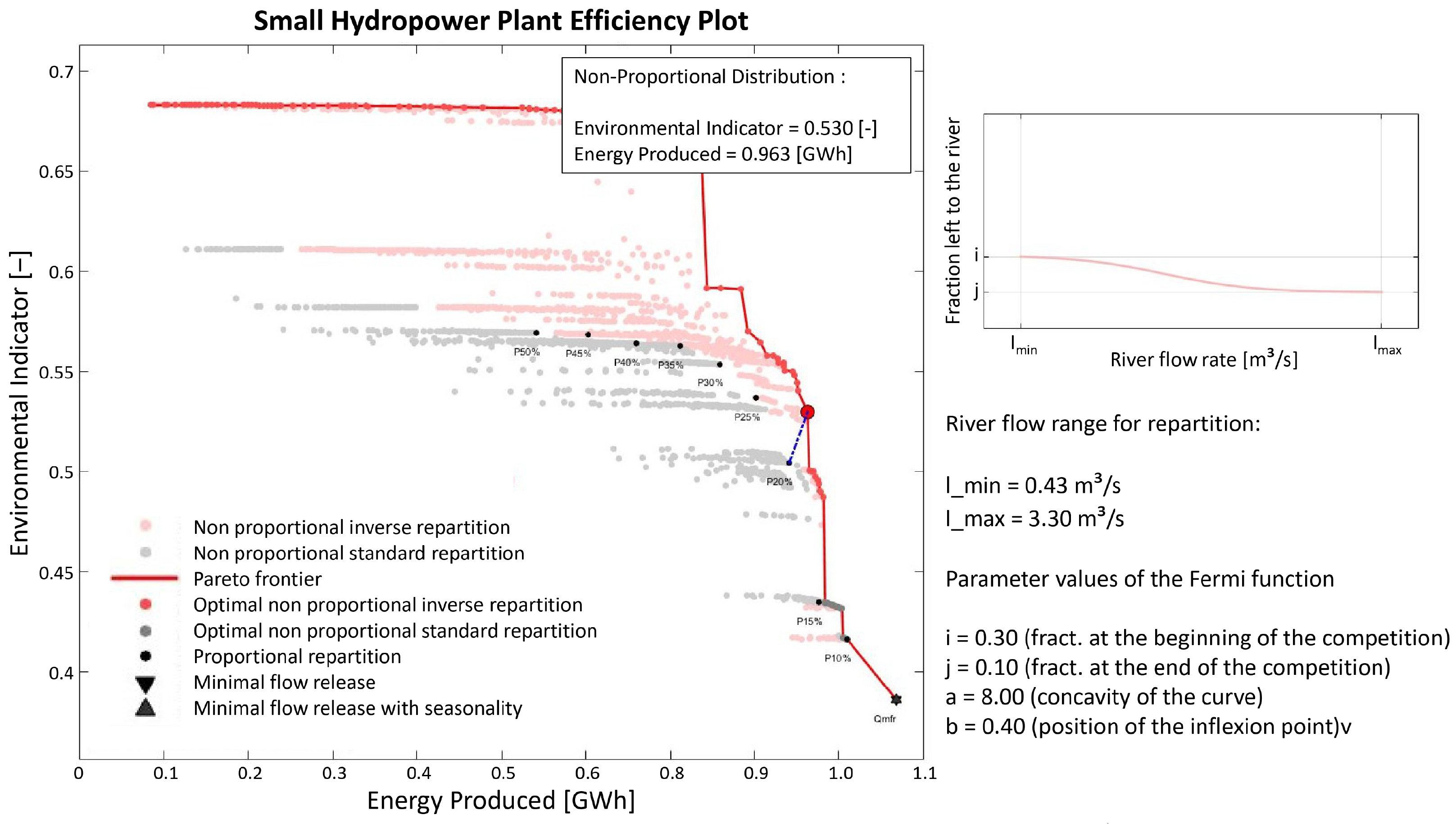
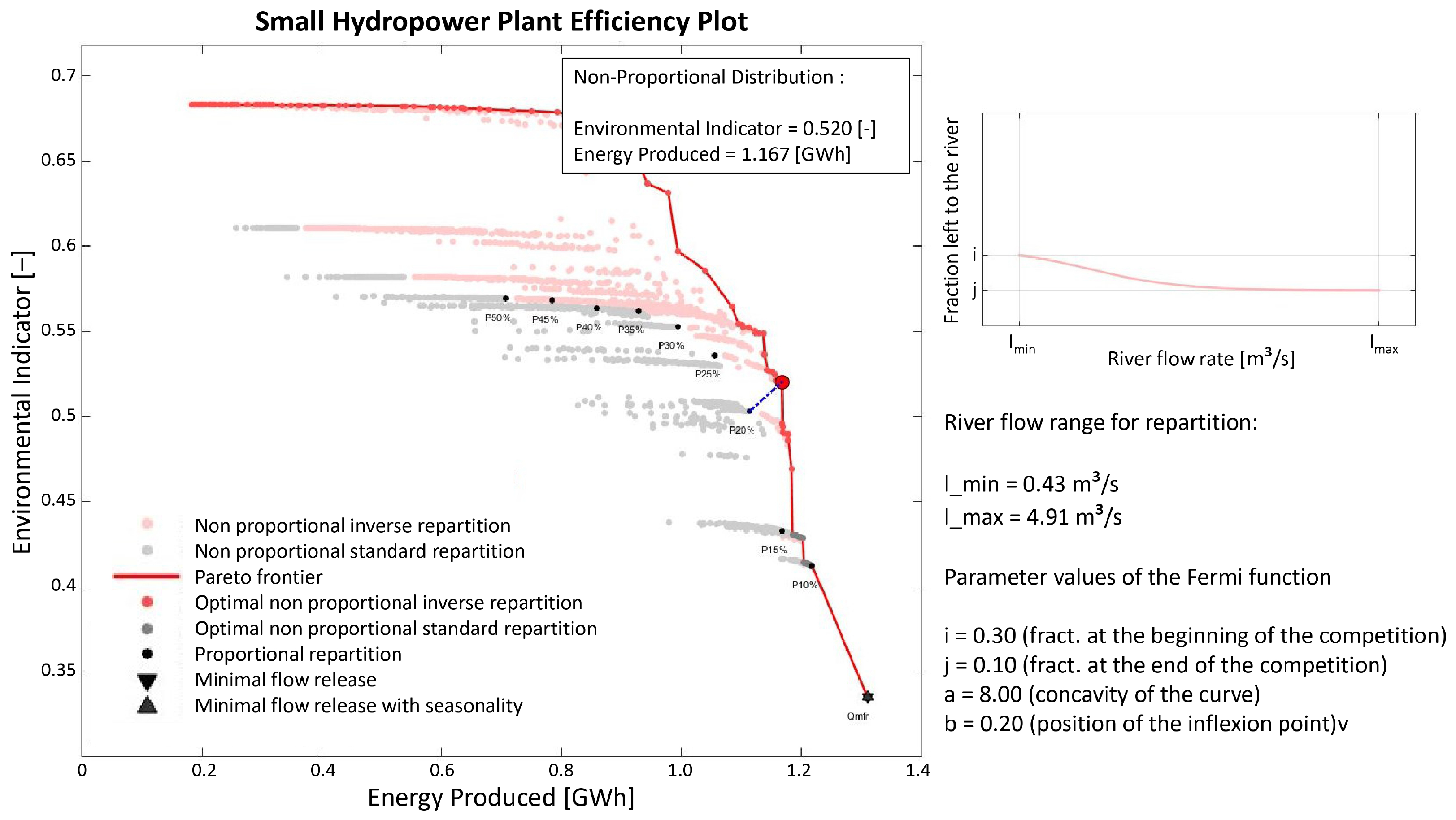

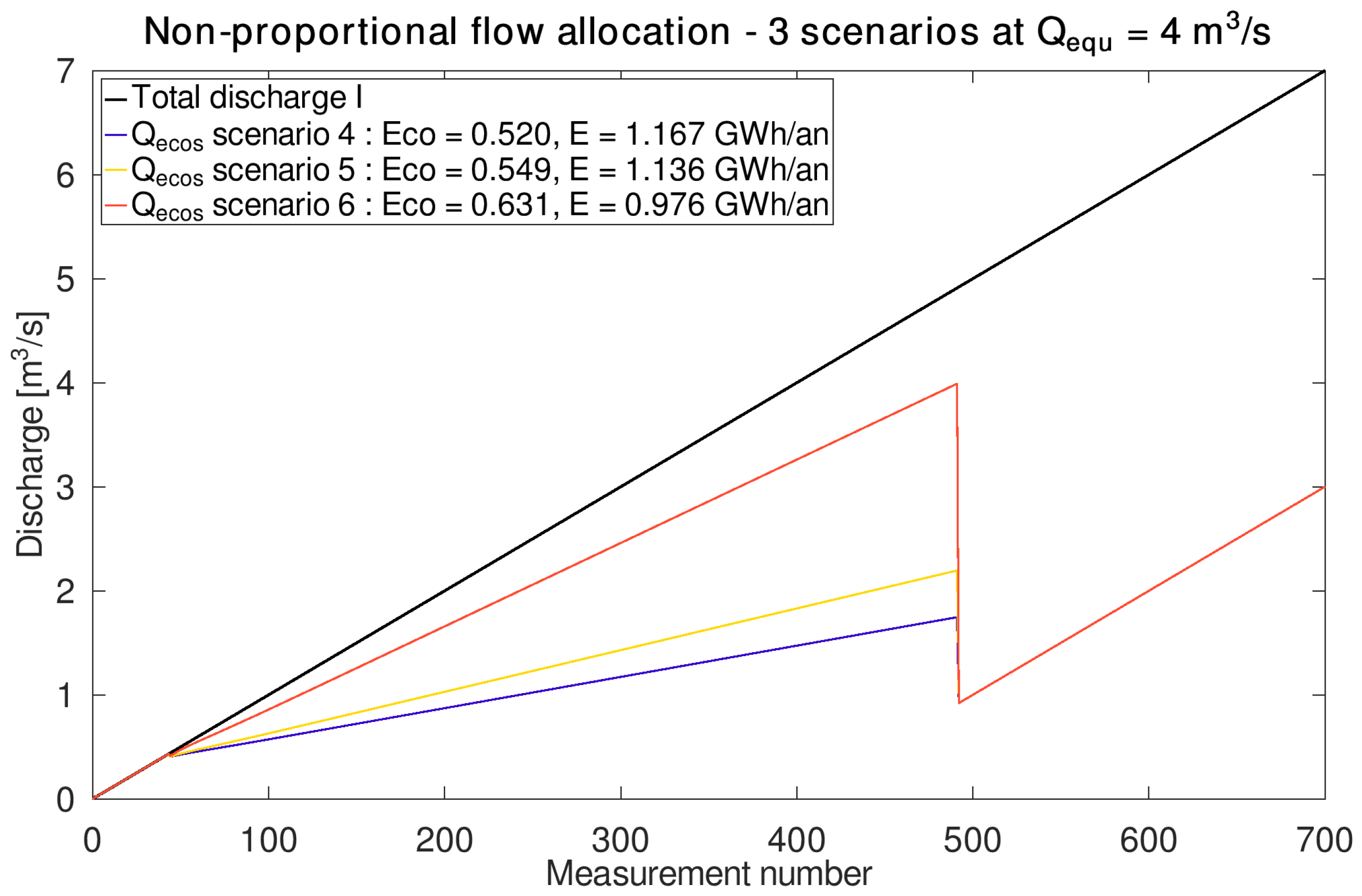
| Species | Barbel | Sculpin | Minnow | Brown Trout | Grayling |
|---|---|---|---|---|---|
| Latin name | Barbus barbus | Cottus gobio | Phoxinus phoxinus | Salmo trutta fario | Thymallus thymallus |
| Sector S1 | 2 | 152 | 3 | 215 | 43 |
| Sector S2 | 18 | 238 | 0 | 328 | 10 |
| S | Eco | EcoAct | Eco/ EcoAct | E | EAct | E/ EAct | Qequ | Imin | Imax | a | b | i | j |
|---|---|---|---|---|---|---|---|---|---|---|---|---|---|
| - | - | % | GWh | GWh | % | m3/s | m3/s | m3/s | - | - | - | - | |
| 1 | 0.530 | 0.385 | +37.7 | 0.963 | 1.07 | −10.0 | 2.55 | 4.3 | 3.3 | 8 | 0.4 | 0.3 | 0.1 |
| 2 | 0.591 | 0.385 | +53.5 | 0.884 | 1.07 | −17.4 | 2.55 | 4.3 | 3.3 | 8 | 0.2 | 0.8 | 0.1 |
| 3 | 0.663 | 0.385 | +72.2 | 0.836 | 1.07 | −21.9 | 2.55 | 4.3 | 3.3 | 8 | 0.3 | 0.8 | 0.1 |
| 4 | 0.520 | 0.385 | +35.1 | 1.167 | 1.07 | +9.1 | 4 | 4.3 | 4.91 | 8 | 0.2 | 0.3 | 0.1 |
| 5 | 0.549 | 0.385 | +42.6 | 1.136 | 1.07 | +6.2 | 4 | 4.3 | 4.91 | 8 | 0.2 | 0.4 | 0.1 |
| 6 | 0.631 | 0.385 | +63.9 | 0.976 | 1.07 | −8.8 | 4 | 4.3 | 4.91 | 8 | 0.2 | 0.8 | 0.1 |
Disclaimer/Publisher’s Note: The statements, opinions and data contained in all publications are solely those of the individual author(s) and contributor(s) and not of MDPI and/or the editor(s). MDPI and/or the editor(s) disclaim responsibility for any injury to people or property resulting from any ideas, methods, instructions or products referred to in the content. |
© 2024 by the authors. Licensee MDPI, Basel, Switzerland. This article is an open access article distributed under the terms and conditions of the Creative Commons Attribution (CC BY) license (https://creativecommons.org/licenses/by/4.0/).
Share and Cite
Angeles, R.; Della Croce, P.; Ferrario, F.; De Cesare, G. Ecological Flow Assessment: Balancing Trout and Grayling Habitat Ecology and Hydroelectric Production. Sustainability 2024, 16, 9473. https://doi.org/10.3390/su16219473
Angeles R, Della Croce P, Ferrario F, De Cesare G. Ecological Flow Assessment: Balancing Trout and Grayling Habitat Ecology and Hydroelectric Production. Sustainability. 2024; 16(21):9473. https://doi.org/10.3390/su16219473
Chicago/Turabian StyleAngeles, Raphaël, Patrick Della Croce, Federico Ferrario, and Giovanni De Cesare. 2024. "Ecological Flow Assessment: Balancing Trout and Grayling Habitat Ecology and Hydroelectric Production" Sustainability 16, no. 21: 9473. https://doi.org/10.3390/su16219473
APA StyleAngeles, R., Della Croce, P., Ferrario, F., & De Cesare, G. (2024). Ecological Flow Assessment: Balancing Trout and Grayling Habitat Ecology and Hydroelectric Production. Sustainability, 16(21), 9473. https://doi.org/10.3390/su16219473






